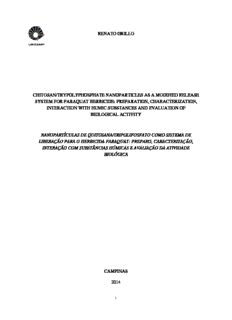
renato grillo chitosan/trypolyphosphate nanoparticles as a modified release system for paraquat ... PDF
Preview renato grillo chitosan/trypolyphosphate nanoparticles as a modified release system for paraquat ...
RENATO GRILLO CHITOSAN/TRYPOLYPHOSPHATE NANOPARTICLES AS A MODIFIED RELEASE SYSTEM FOR PARAQUAT HERBICIDE: PREPARATION, CHARACTERIZATION, INTERACTION WITH HUMIC SUBSTANCES AND EVALUATION OF BIOLOGICAL ACTIVITY NANOPARTÍCULAS DE QUITOSANA/TRIPOLIFOSFATO COMO SISTEMA DE LIBERAÇÃO PARA O HERBICIDA PARAQUAT: PREPARO, CARACTERIZAÇÃO, INTERAÇÃO COM SUBSTÂNCIAS HÚMICAS E AVALIAÇÃO DA ATIVIDADE BIOLÓGICA CAMPINAS 2014 i ii iii iv v vi ABSTRACT Agrochemicals have become one of the most important compounds used in the world and are the main responsible for the increase in agricultural production. Paraquat, a non- selective herbicide used in several crops in the world, has high toxicity to living beings and considerable persistence in the soil, which led to its banishment in some countries. Although agrochemicals have an important function in increasing food production by minimizing pests, they can cause serious environmental impacts through contamination of soil and water resources. With the nanotechnology growth, several mechanisms have been studied in order to minimize these damages, such as the development of modified release systems using biodegradable polymers, which allows an increase in performance/efficiency of the product. Studies indicate that the natural organic matter present in the soil, sediment and water can interact with agrochemicals and nanoparticles, and therefore, modify the destination of these substances in the environment. The purpose of the present Thesis is to show results of the development and characterization of chitosan/trypolyphosphate polymeric nanoparticles for modified release of the Paraquat herbicide, as well as to study the stability and toxicity of this nanoparticles with the presence or absence of natural organic matter (mainly in the form of humic substances). Herbicide activity and sorption of the nanoparticulate herbicide in the soil were also evaluated. Chitosan/trypolyphosphate nanoparticles (with or without Paraquat) have been prepared by ionic gelation method and presented average size, polydispersity index and zeta potential of ~ 300 nm, 0.250 and 45 mV, respectively. The Paraquat encapsulation efficiency was 62.6 ± 0.7 % and the nanoparticles showed themselves spherical and good colloidal stability. The release kinetics and sorption test in the soil showed that the nanoparticles modified the diffusion and release of herbicide and the mathematical model vii that best described the sorption kinetics was pseudo-second order. Cytotoxicity, genotoxicity and ecotoxicity tests indicated that the association of Paraquat with the nanoparticles reduced the toxic effect, since less herbicide was released into the environment as function of time, but even so, the herbicidal activity was preserved or enhanced. The presence of humic substances in the medium altered the dynamic equilibrium of the herbicide in solution, and diminished the toxicity of the nanoparticle/paraquat system. This study has innovative and promising results that open new discussions and perspectives for the development of modified release systems for agrochemicals. Keywords: Controlled release, Polymeric nanoparticles, Paraquat, Organic Matter, Nanotoxicology. viii RESUMO Os defensivos agrícolas tornaram-se alguns dos mais importantes compostos utilizados no mundo e são os principais responsáveis pelo aumento da produção agrícola. O Paraquat, um herbicida não seletivo de contato utilizado em diversas culturas no mundo, apresenta alta toxicidade para os seres vivos e considerável persistência no solo, o que fez com que ele fosse banido em alguns países. Embora os defensivos agrícolas possuam uma importante função no aumento da produção de alimentos, através do controle de pragas, eles podem gerar sérios impactos ambientais, através da contaminação dos recursos hídricos e do solo. Com o crescimento da nanotecnologia, diversos mecanismos estão sendo estudados a fim de minimizar estes danos, tais como o desenvolvimento de sistemas de liberação modificada, utilizando polímeros biodegradáveis, o qual permite um aumento no desempenho/eficiência do produto. Estudos indicam que a matéria orgânica natural presente no solo, sedimento e água podem interagir com os defensivos agrícolas e nanopartículas e consequentemente modificar o destino destas substâncias no ambiente. A presente Tese tem como objetivo principal mostrar resultados do desenvolvimento e caracterização de nanopartículas poliméricas de quitosana/tripolifosfato para liberação modificada do herbicida Paraquat, bem como, estudar a estabilidade e a toxicidade deste sistema nanoparticulado com a presença ou ausência de matéria orgânica natural (na forma de substâncias húmicas). A atividade herbicida e a sorção do herbicida nanoparticulado no solo também foram avaliados. Nanopartículas de quitosana/tripolifosfato (com ou sem Paraquat) foram preparadas pelo método de gelificação iônica e apresentaram tamanho médio, índice de polidispersão e potencial zeta de ~ 300 nm, 0,250 e 45 mV, respectivamente. A eficiência de encapsulação do Paraquat foi de 62,6 ± 0,7 % e as nanopartículas apresentaram-se ix esféricas e com boa estabilidade coloidal. A cinética de liberação e o ensaio de sorção no solo mostraram que as nanopartículas retardaram a difusão e a liberação do herbicida e o modelo matemático que melhor descreveu a cinética de sorção foi o de pseudo-segunda ordem. Ensaios de citotoxicidade, genotoxicidade e ecotoxicidade indicaram que a associação do Paraquat às nanopartículas reduziram o efeito tóxico, uma vez que menos herbicida foi liberado para o ambiente em função do tempo, e ainda assim a atividade herbicida foi preservada ou aumentada. A presença de substâncias húmicas naturais não alterou os parâmetros físico-químicos estudados; entretanto, mostrou que pode reduzir a genotoxicidade e a ecotoxicidade do herbicida quando associado às nanopartículas, através de modificações na dinâmica do sistema. Este trabalho possui resultados inovadores e promissores que abrem novas discussões e perspectivas para o desenvolvimento de sistemas de liberação modificada para defensivos agrícolas. Palavras chaves: Liberação modificada, Nanopartículas poliméricas, Paraquat, Matéria Orgânica, Nanotoxicologia. x
Description: